Detailed Report: Curriculum Design, Development, and Evaluation
VerifiedAdded on 2023/06/08
|21
|6153
|204
Report
AI Summary
This report delves into the multifaceted realm of curriculum design and development, commencing with an exploration of its underlying motives, encompassing academic, social, economic, and political dimensions. It subsequently examines various approaches and models, including student-centered, subject-centered, and difficulty-centered approaches, alongside product and process models. The report emphasizes the crucial role of learner feedback, risk management strategies, and methodologies employed for monitoring and evaluating curriculum effectiveness. Furthermore, it outlines the process of identifying learning objectives, developing a sample curriculum for an education and training program, planning assessment approaches, and producing supportive resources. Finally, the report culminates in an evaluation of learning outcomes, curriculum delivery, identification of areas for improvement, and recommendations for enhancing the overall curriculum design.
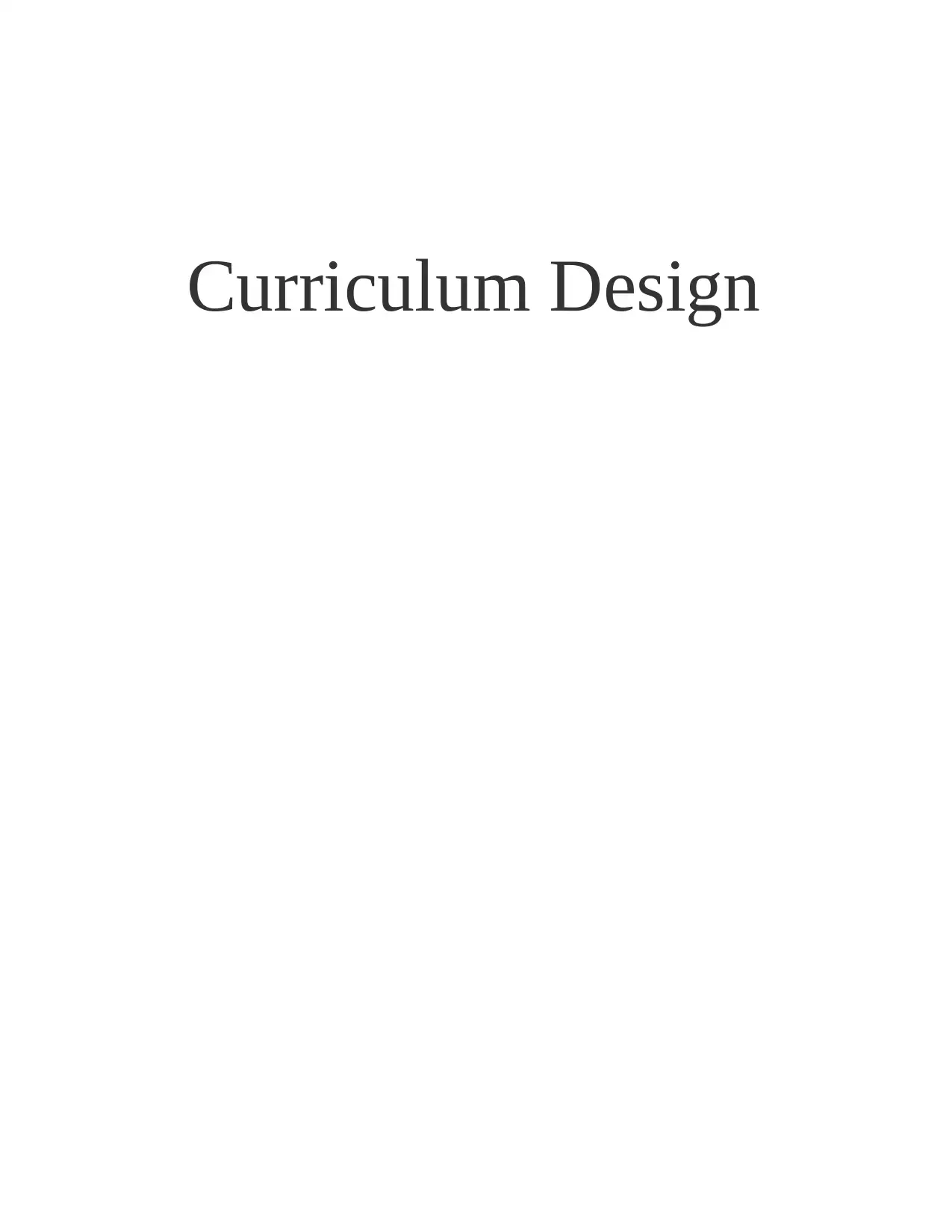
Curriculum Design
Paraphrase This Document
Need a fresh take? Get an instant paraphrase of this document with our AI Paraphraser
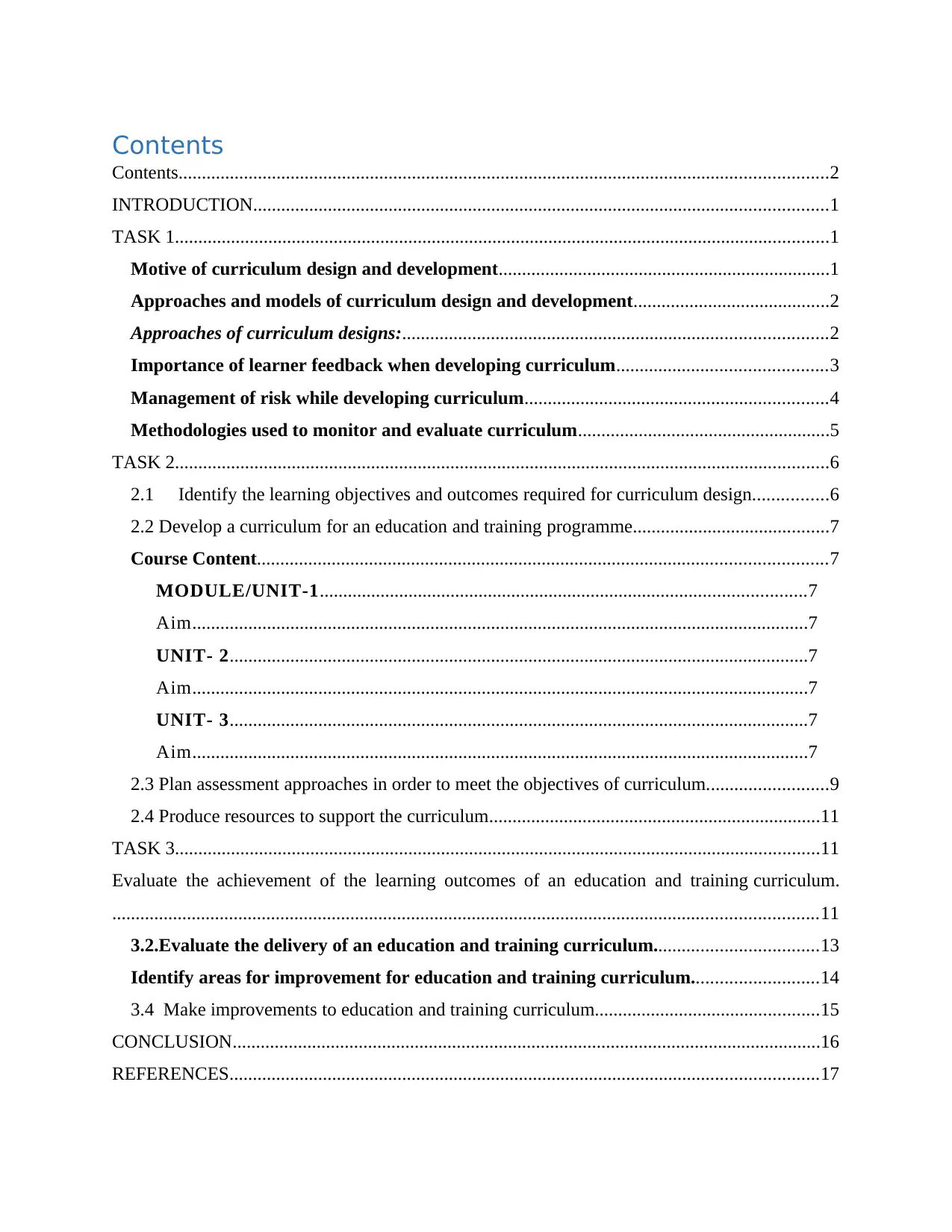
Contents
Contents...........................................................................................................................................2
INTRODUCTION...........................................................................................................................1
TASK 1............................................................................................................................................1
Motive of curriculum design and development.......................................................................1
Approaches and models of curriculum design and development..........................................2
Approaches of curriculum designs:...........................................................................................2
Importance of learner feedback when developing curriculum.............................................3
Management of risk while developing curriculum.................................................................4
Methodologies used to monitor and evaluate curriculum......................................................5
TASK 2............................................................................................................................................6
2.1 Identify the learning objectives and outcomes required for curriculum design................6
2.2 Develop a curriculum for an education and training programme..........................................7
Course Content..........................................................................................................................7
MODULE/UNIT-1........................................................................................................7
Aim....................................................................................................................................7
UNIT- 2............................................................................................................................7
Aim....................................................................................................................................7
UNIT- 3............................................................................................................................7
Aim....................................................................................................................................7
2.3 Plan assessment approaches in order to meet the objectives of curriculum..........................9
2.4 Produce resources to support the curriculum.......................................................................11
TASK 3..........................................................................................................................................11
Evaluate the achievement of the learning outcomes of an education and training curriculum.
.......................................................................................................................................................11
3.2.Evaluate the delivery of an education and training curriculum...................................13
Identify areas for improvement for education and training curriculum...........................14
3.4 Make improvements to education and training curriculum................................................15
CONCLUSION..............................................................................................................................16
REFERENCES..............................................................................................................................17
Contents...........................................................................................................................................2
INTRODUCTION...........................................................................................................................1
TASK 1............................................................................................................................................1
Motive of curriculum design and development.......................................................................1
Approaches and models of curriculum design and development..........................................2
Approaches of curriculum designs:...........................................................................................2
Importance of learner feedback when developing curriculum.............................................3
Management of risk while developing curriculum.................................................................4
Methodologies used to monitor and evaluate curriculum......................................................5
TASK 2............................................................................................................................................6
2.1 Identify the learning objectives and outcomes required for curriculum design................6
2.2 Develop a curriculum for an education and training programme..........................................7
Course Content..........................................................................................................................7
MODULE/UNIT-1........................................................................................................7
Aim....................................................................................................................................7
UNIT- 2............................................................................................................................7
Aim....................................................................................................................................7
UNIT- 3............................................................................................................................7
Aim....................................................................................................................................7
2.3 Plan assessment approaches in order to meet the objectives of curriculum..........................9
2.4 Produce resources to support the curriculum.......................................................................11
TASK 3..........................................................................................................................................11
Evaluate the achievement of the learning outcomes of an education and training curriculum.
.......................................................................................................................................................11
3.2.Evaluate the delivery of an education and training curriculum...................................13
Identify areas for improvement for education and training curriculum...........................14
3.4 Make improvements to education and training curriculum................................................15
CONCLUSION..............................................................................................................................16
REFERENCES..............................................................................................................................17

⊘ This is a preview!⊘
Do you want full access?
Subscribe today to unlock all pages.

Trusted by 1+ million students worldwide
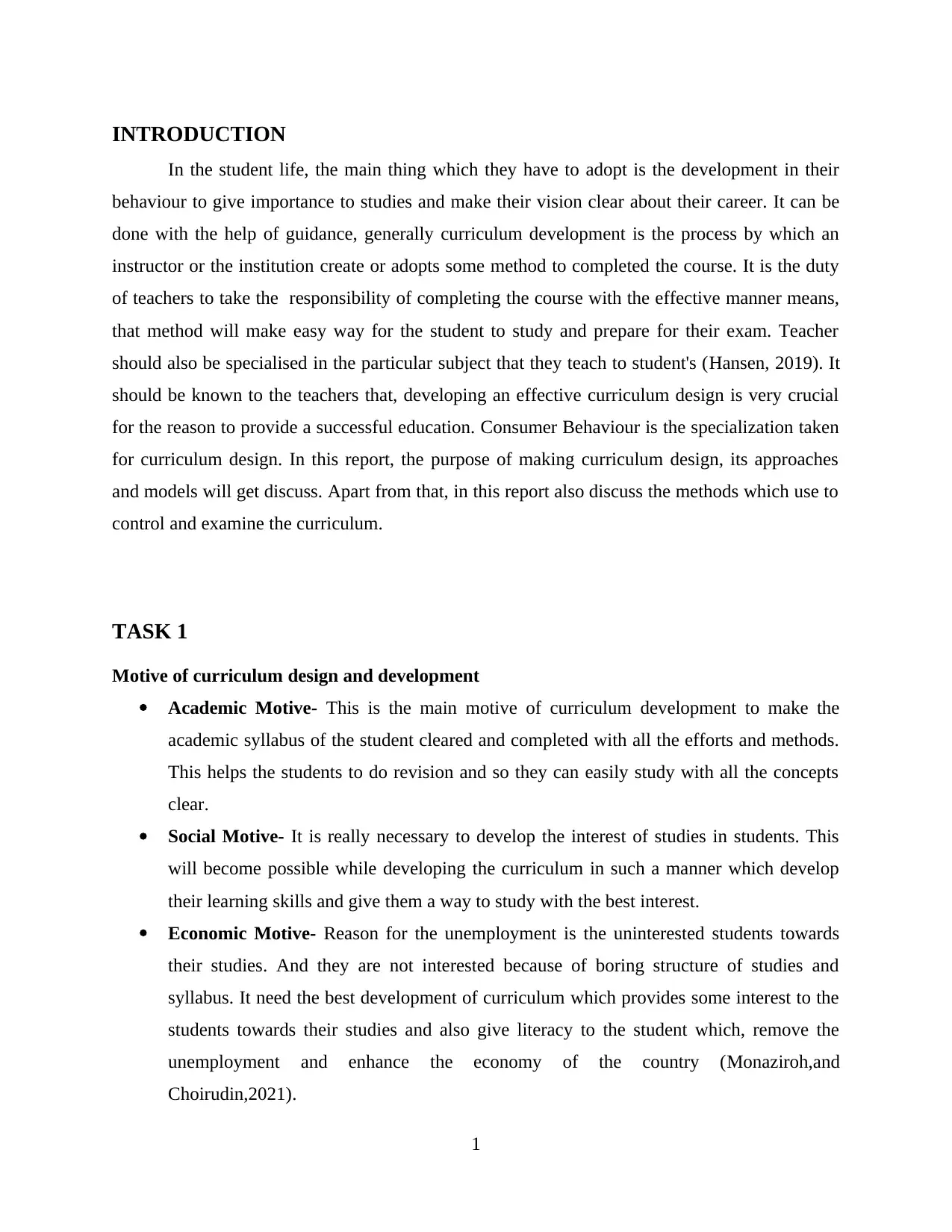
INTRODUCTION
In the student life, the main thing which they have to adopt is the development in their
behaviour to give importance to studies and make their vision clear about their career. It can be
done with the help of guidance, generally curriculum development is the process by which an
instructor or the institution create or adopts some method to completed the course. It is the duty
of teachers to take the responsibility of completing the course with the effective manner means,
that method will make easy way for the student to study and prepare for their exam. Teacher
should also be specialised in the particular subject that they teach to student's (Hansen, 2019). It
should be known to the teachers that, developing an effective curriculum design is very crucial
for the reason to provide a successful education. Consumer Behaviour is the specialization taken
for curriculum design. In this report, the purpose of making curriculum design, its approaches
and models will get discuss. Apart from that, in this report also discuss the methods which use to
control and examine the curriculum.
TASK 1
Motive of curriculum design and development
Academic Motive- This is the main motive of curriculum development to make the
academic syllabus of the student cleared and completed with all the efforts and methods.
This helps the students to do revision and so they can easily study with all the concepts
clear.
Social Motive- It is really necessary to develop the interest of studies in students. This
will become possible while developing the curriculum in such a manner which develop
their learning skills and give them a way to study with the best interest.
Economic Motive- Reason for the unemployment is the uninterested students towards
their studies. And they are not interested because of boring structure of studies and
syllabus. It need the best development of curriculum which provides some interest to the
students towards their studies and also give literacy to the student which, remove the
unemployment and enhance the economy of the country (Monaziroh,and
Choirudin,2021).
1
In the student life, the main thing which they have to adopt is the development in their
behaviour to give importance to studies and make their vision clear about their career. It can be
done with the help of guidance, generally curriculum development is the process by which an
instructor or the institution create or adopts some method to completed the course. It is the duty
of teachers to take the responsibility of completing the course with the effective manner means,
that method will make easy way for the student to study and prepare for their exam. Teacher
should also be specialised in the particular subject that they teach to student's (Hansen, 2019). It
should be known to the teachers that, developing an effective curriculum design is very crucial
for the reason to provide a successful education. Consumer Behaviour is the specialization taken
for curriculum design. In this report, the purpose of making curriculum design, its approaches
and models will get discuss. Apart from that, in this report also discuss the methods which use to
control and examine the curriculum.
TASK 1
Motive of curriculum design and development
Academic Motive- This is the main motive of curriculum development to make the
academic syllabus of the student cleared and completed with all the efforts and methods.
This helps the students to do revision and so they can easily study with all the concepts
clear.
Social Motive- It is really necessary to develop the interest of studies in students. This
will become possible while developing the curriculum in such a manner which develop
their learning skills and give them a way to study with the best interest.
Economic Motive- Reason for the unemployment is the uninterested students towards
their studies. And they are not interested because of boring structure of studies and
syllabus. It need the best development of curriculum which provides some interest to the
students towards their studies and also give literacy to the student which, remove the
unemployment and enhance the economy of the country (Monaziroh,and
Choirudin,2021).
1
Paraphrase This Document
Need a fresh take? Get an instant paraphrase of this document with our AI Paraphraser
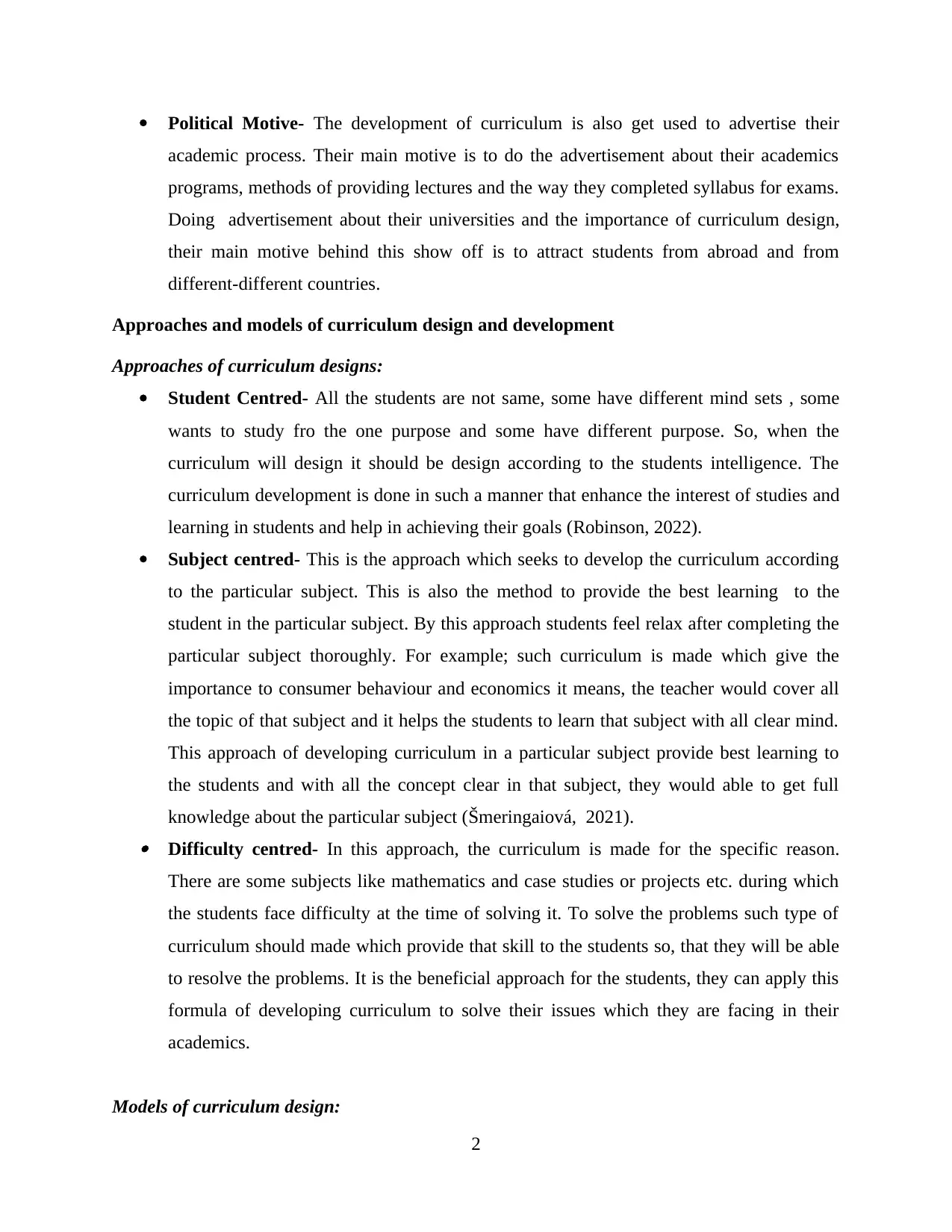
Political Motive- The development of curriculum is also get used to advertise their
academic process. Their main motive is to do the advertisement about their academics
programs, methods of providing lectures and the way they completed syllabus for exams.
Doing advertisement about their universities and the importance of curriculum design,
their main motive behind this show off is to attract students from abroad and from
different-different countries.
Approaches and models of curriculum design and development
Approaches of curriculum designs:
Student Centred- All the students are not same, some have different mind sets , some
wants to study fro the one purpose and some have different purpose. So, when the
curriculum will design it should be design according to the students intelligence. The
curriculum development is done in such a manner that enhance the interest of studies and
learning in students and help in achieving their goals (Robinson, 2022).
Subject centred- This is the approach which seeks to develop the curriculum according
to the particular subject. This is also the method to provide the best learning to the
student in the particular subject. By this approach students feel relax after completing the
particular subject thoroughly. For example; such curriculum is made which give the
importance to consumer behaviour and economics it means, the teacher would cover all
the topic of that subject and it helps the students to learn that subject with all clear mind.
This approach of developing curriculum in a particular subject provide best learning to
the students and with all the concept clear in that subject, they would able to get full
knowledge about the particular subject (Šmeringaiová, 2021). Difficulty centred- In this approach, the curriculum is made for the specific reason.
There are some subjects like mathematics and case studies or projects etc. during which
the students face difficulty at the time of solving it. To solve the problems such type of
curriculum should made which provide that skill to the students so, that they will be able
to resolve the problems. It is the beneficial approach for the students, they can apply this
formula of developing curriculum to solve their issues which they are facing in their
academics.
Models of curriculum design:
2
academic process. Their main motive is to do the advertisement about their academics
programs, methods of providing lectures and the way they completed syllabus for exams.
Doing advertisement about their universities and the importance of curriculum design,
their main motive behind this show off is to attract students from abroad and from
different-different countries.
Approaches and models of curriculum design and development
Approaches of curriculum designs:
Student Centred- All the students are not same, some have different mind sets , some
wants to study fro the one purpose and some have different purpose. So, when the
curriculum will design it should be design according to the students intelligence. The
curriculum development is done in such a manner that enhance the interest of studies and
learning in students and help in achieving their goals (Robinson, 2022).
Subject centred- This is the approach which seeks to develop the curriculum according
to the particular subject. This is also the method to provide the best learning to the
student in the particular subject. By this approach students feel relax after completing the
particular subject thoroughly. For example; such curriculum is made which give the
importance to consumer behaviour and economics it means, the teacher would cover all
the topic of that subject and it helps the students to learn that subject with all clear mind.
This approach of developing curriculum in a particular subject provide best learning to
the students and with all the concept clear in that subject, they would able to get full
knowledge about the particular subject (Šmeringaiová, 2021). Difficulty centred- In this approach, the curriculum is made for the specific reason.
There are some subjects like mathematics and case studies or projects etc. during which
the students face difficulty at the time of solving it. To solve the problems such type of
curriculum should made which provide that skill to the students so, that they will be able
to resolve the problems. It is the beneficial approach for the students, they can apply this
formula of developing curriculum to solve their issues which they are facing in their
academics.
Models of curriculum design:
2
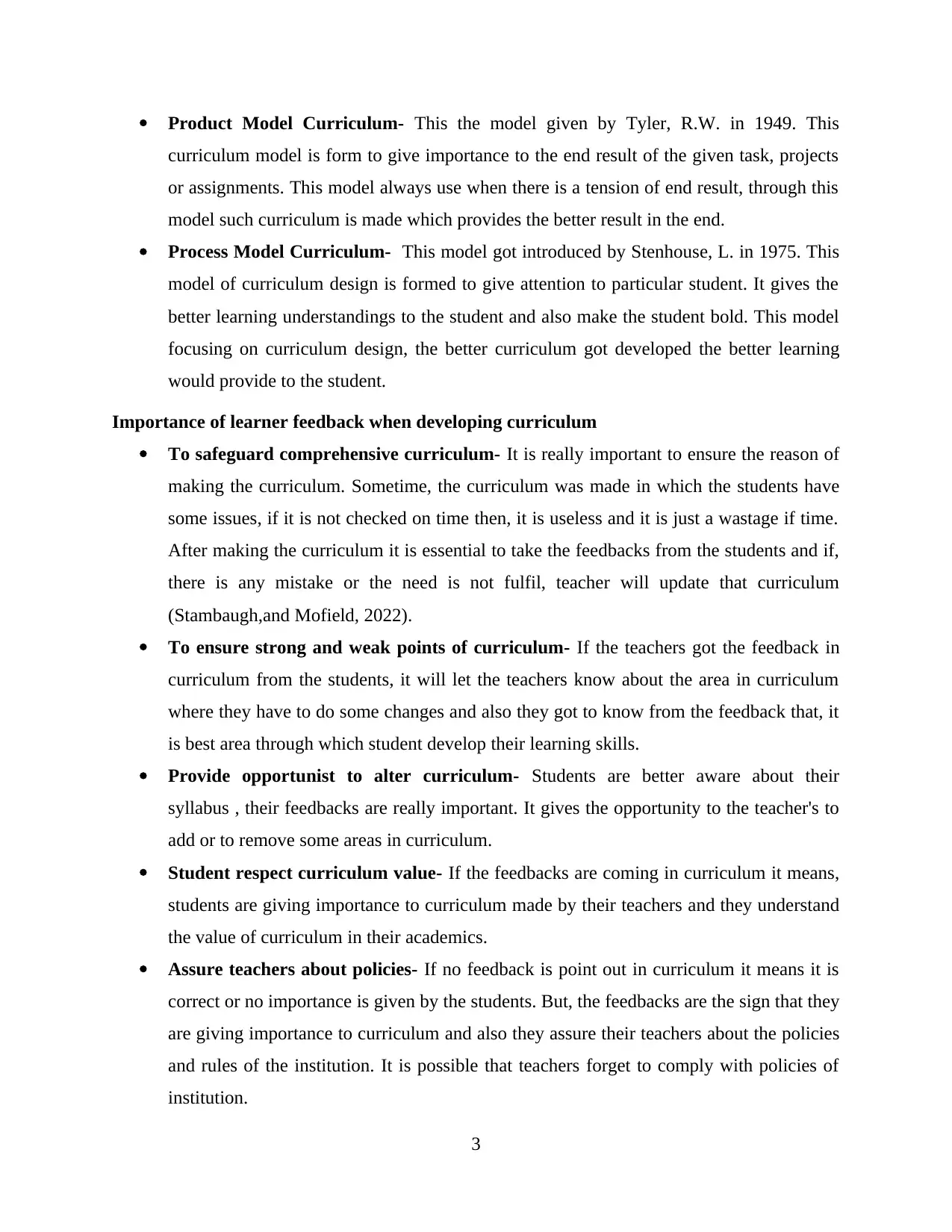
Product Model Curriculum- This the model given by Tyler, R.W. in 1949. This
curriculum model is form to give importance to the end result of the given task, projects
or assignments. This model always use when there is a tension of end result, through this
model such curriculum is made which provides the better result in the end.
Process Model Curriculum- This model got introduced by Stenhouse, L. in 1975. This
model of curriculum design is formed to give attention to particular student. It gives the
better learning understandings to the student and also make the student bold. This model
focusing on curriculum design, the better curriculum got developed the better learning
would provide to the student.
Importance of learner feedback when developing curriculum
To safeguard comprehensive curriculum- It is really important to ensure the reason of
making the curriculum. Sometime, the curriculum was made in which the students have
some issues, if it is not checked on time then, it is useless and it is just a wastage if time.
After making the curriculum it is essential to take the feedbacks from the students and if,
there is any mistake or the need is not fulfil, teacher will update that curriculum
(Stambaugh,and Mofield, 2022).
To ensure strong and weak points of curriculum- If the teachers got the feedback in
curriculum from the students, it will let the teachers know about the area in curriculum
where they have to do some changes and also they got to know from the feedback that, it
is best area through which student develop their learning skills.
Provide opportunist to alter curriculum- Students are better aware about their
syllabus , their feedbacks are really important. It gives the opportunity to the teacher's to
add or to remove some areas in curriculum.
Student respect curriculum value- If the feedbacks are coming in curriculum it means,
students are giving importance to curriculum made by their teachers and they understand
the value of curriculum in their academics.
Assure teachers about policies- If no feedback is point out in curriculum it means it is
correct or no importance is given by the students. But, the feedbacks are the sign that they
are giving importance to curriculum and also they assure their teachers about the policies
and rules of the institution. It is possible that teachers forget to comply with policies of
institution.
3
curriculum model is form to give importance to the end result of the given task, projects
or assignments. This model always use when there is a tension of end result, through this
model such curriculum is made which provides the better result in the end.
Process Model Curriculum- This model got introduced by Stenhouse, L. in 1975. This
model of curriculum design is formed to give attention to particular student. It gives the
better learning understandings to the student and also make the student bold. This model
focusing on curriculum design, the better curriculum got developed the better learning
would provide to the student.
Importance of learner feedback when developing curriculum
To safeguard comprehensive curriculum- It is really important to ensure the reason of
making the curriculum. Sometime, the curriculum was made in which the students have
some issues, if it is not checked on time then, it is useless and it is just a wastage if time.
After making the curriculum it is essential to take the feedbacks from the students and if,
there is any mistake or the need is not fulfil, teacher will update that curriculum
(Stambaugh,and Mofield, 2022).
To ensure strong and weak points of curriculum- If the teachers got the feedback in
curriculum from the students, it will let the teachers know about the area in curriculum
where they have to do some changes and also they got to know from the feedback that, it
is best area through which student develop their learning skills.
Provide opportunist to alter curriculum- Students are better aware about their
syllabus , their feedbacks are really important. It gives the opportunity to the teacher's to
add or to remove some areas in curriculum.
Student respect curriculum value- If the feedbacks are coming in curriculum it means,
students are giving importance to curriculum made by their teachers and they understand
the value of curriculum in their academics.
Assure teachers about policies- If no feedback is point out in curriculum it means it is
correct or no importance is given by the students. But, the feedbacks are the sign that they
are giving importance to curriculum and also they assure their teachers about the policies
and rules of the institution. It is possible that teachers forget to comply with policies of
institution.
3
⊘ This is a preview!⊘
Do you want full access?
Subscribe today to unlock all pages.

Trusted by 1+ million students worldwide
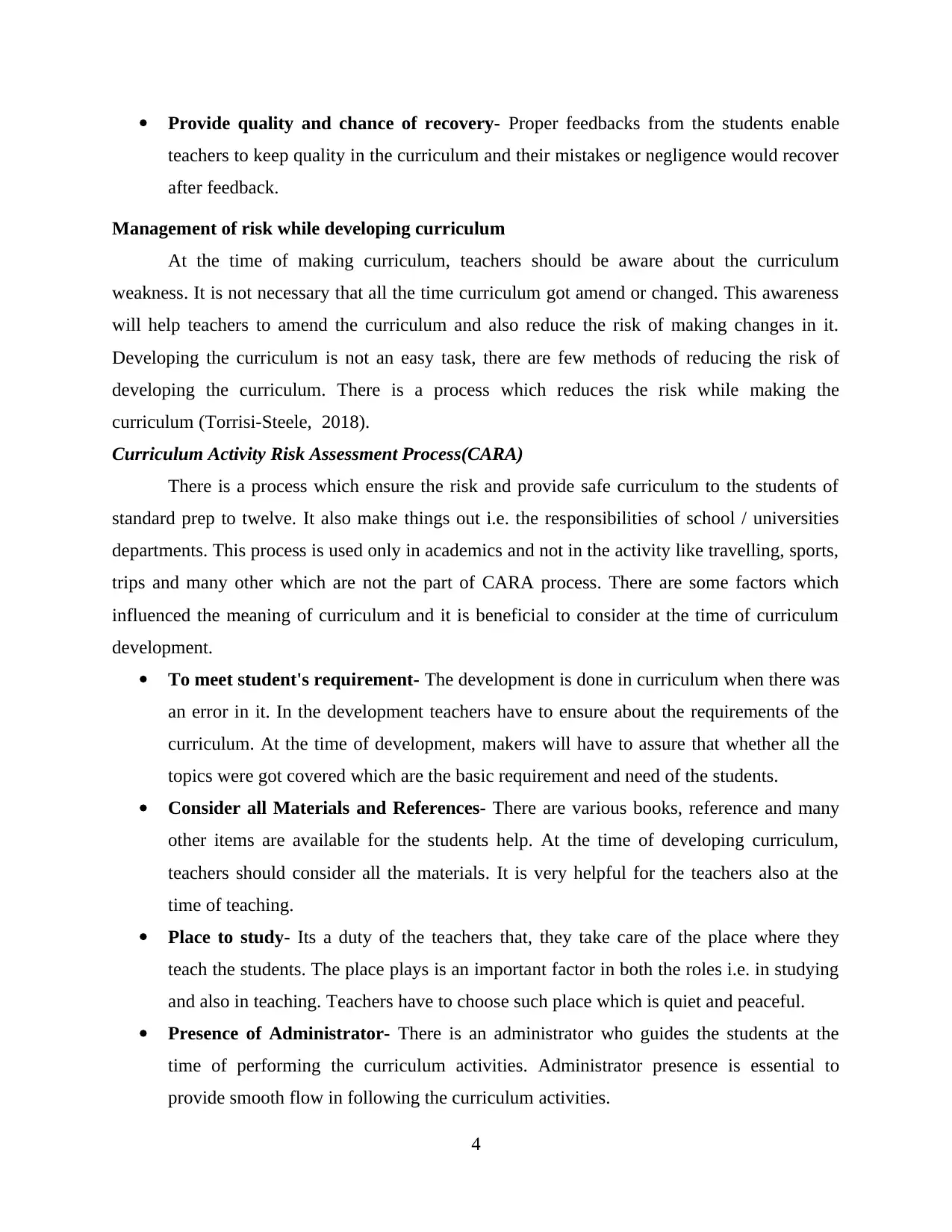
Provide quality and chance of recovery- Proper feedbacks from the students enable
teachers to keep quality in the curriculum and their mistakes or negligence would recover
after feedback.
Management of risk while developing curriculum
At the time of making curriculum, teachers should be aware about the curriculum
weakness. It is not necessary that all the time curriculum got amend or changed. This awareness
will help teachers to amend the curriculum and also reduce the risk of making changes in it.
Developing the curriculum is not an easy task, there are few methods of reducing the risk of
developing the curriculum. There is a process which reduces the risk while making the
curriculum (Torrisi-Steele, 2018).
Curriculum Activity Risk Assessment Process(CARA)
There is a process which ensure the risk and provide safe curriculum to the students of
standard prep to twelve. It also make things out i.e. the responsibilities of school / universities
departments. This process is used only in academics and not in the activity like travelling, sports,
trips and many other which are not the part of CARA process. There are some factors which
influenced the meaning of curriculum and it is beneficial to consider at the time of curriculum
development.
To meet student's requirement- The development is done in curriculum when there was
an error in it. In the development teachers have to ensure about the requirements of the
curriculum. At the time of development, makers will have to assure that whether all the
topics were got covered which are the basic requirement and need of the students.
Consider all Materials and References- There are various books, reference and many
other items are available for the students help. At the time of developing curriculum,
teachers should consider all the materials. It is very helpful for the teachers also at the
time of teaching.
Place to study- Its a duty of the teachers that, they take care of the place where they
teach the students. The place plays is an important factor in both the roles i.e. in studying
and also in teaching. Teachers have to choose such place which is quiet and peaceful.
Presence of Administrator- There is an administrator who guides the students at the
time of performing the curriculum activities. Administrator presence is essential to
provide smooth flow in following the curriculum activities.
4
teachers to keep quality in the curriculum and their mistakes or negligence would recover
after feedback.
Management of risk while developing curriculum
At the time of making curriculum, teachers should be aware about the curriculum
weakness. It is not necessary that all the time curriculum got amend or changed. This awareness
will help teachers to amend the curriculum and also reduce the risk of making changes in it.
Developing the curriculum is not an easy task, there are few methods of reducing the risk of
developing the curriculum. There is a process which reduces the risk while making the
curriculum (Torrisi-Steele, 2018).
Curriculum Activity Risk Assessment Process(CARA)
There is a process which ensure the risk and provide safe curriculum to the students of
standard prep to twelve. It also make things out i.e. the responsibilities of school / universities
departments. This process is used only in academics and not in the activity like travelling, sports,
trips and many other which are not the part of CARA process. There are some factors which
influenced the meaning of curriculum and it is beneficial to consider at the time of curriculum
development.
To meet student's requirement- The development is done in curriculum when there was
an error in it. In the development teachers have to ensure about the requirements of the
curriculum. At the time of development, makers will have to assure that whether all the
topics were got covered which are the basic requirement and need of the students.
Consider all Materials and References- There are various books, reference and many
other items are available for the students help. At the time of developing curriculum,
teachers should consider all the materials. It is very helpful for the teachers also at the
time of teaching.
Place to study- Its a duty of the teachers that, they take care of the place where they
teach the students. The place plays is an important factor in both the roles i.e. in studying
and also in teaching. Teachers have to choose such place which is quiet and peaceful.
Presence of Administrator- There is an administrator who guides the students at the
time of performing the curriculum activities. Administrator presence is essential to
provide smooth flow in following the curriculum activities.
4
Paraphrase This Document
Need a fresh take? Get an instant paraphrase of this document with our AI Paraphraser
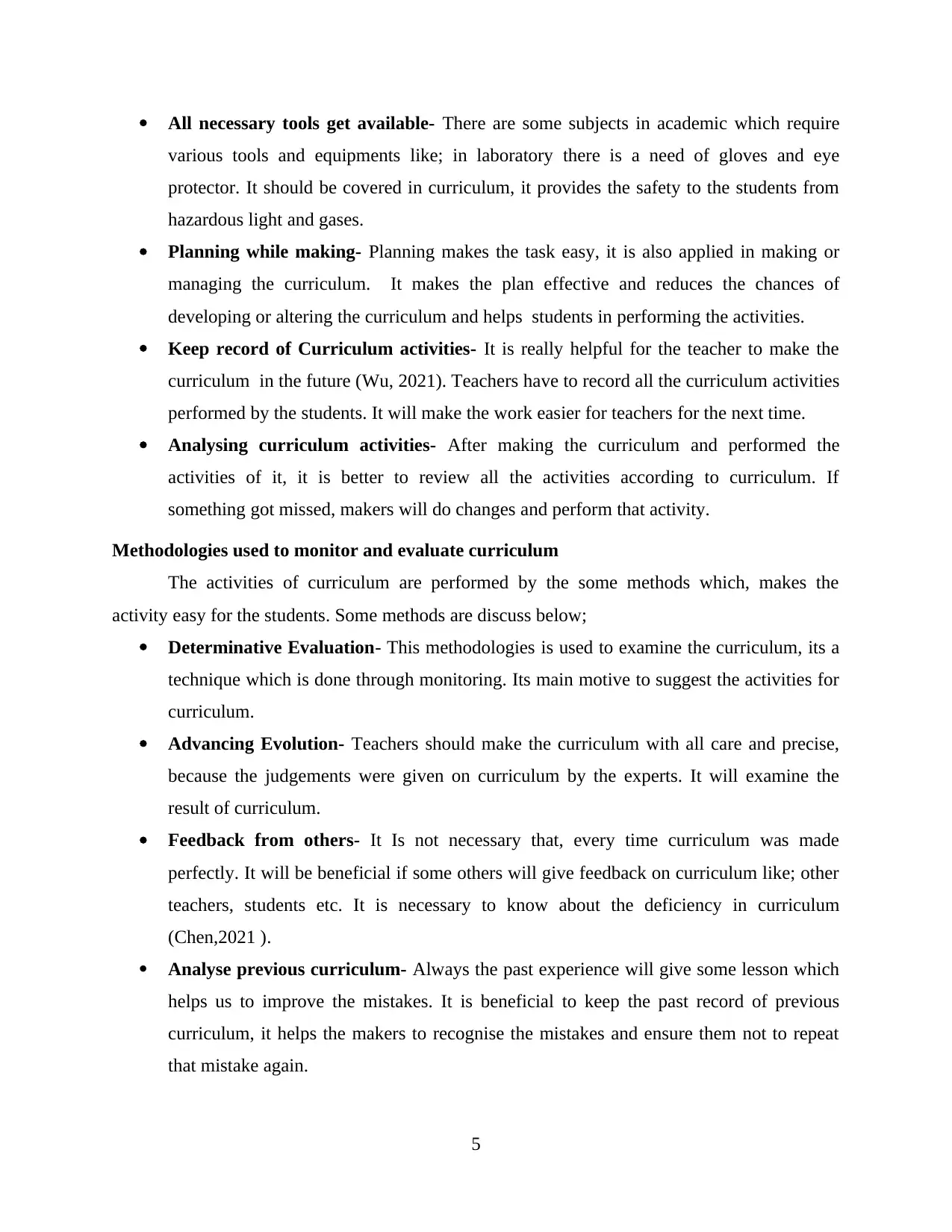
All necessary tools get available- There are some subjects in academic which require
various tools and equipments like; in laboratory there is a need of gloves and eye
protector. It should be covered in curriculum, it provides the safety to the students from
hazardous light and gases.
Planning while making- Planning makes the task easy, it is also applied in making or
managing the curriculum. It makes the plan effective and reduces the chances of
developing or altering the curriculum and helps students in performing the activities.
Keep record of Curriculum activities- It is really helpful for the teacher to make the
curriculum in the future (Wu, 2021). Teachers have to record all the curriculum activities
performed by the students. It will make the work easier for teachers for the next time.
Analysing curriculum activities- After making the curriculum and performed the
activities of it, it is better to review all the activities according to curriculum. If
something got missed, makers will do changes and perform that activity.
Methodologies used to monitor and evaluate curriculum
The activities of curriculum are performed by the some methods which, makes the
activity easy for the students. Some methods are discuss below;
Determinative Evaluation- This methodologies is used to examine the curriculum, its a
technique which is done through monitoring. Its main motive to suggest the activities for
curriculum.
Advancing Evolution- Teachers should make the curriculum with all care and precise,
because the judgements were given on curriculum by the experts. It will examine the
result of curriculum.
Feedback from others- It Is not necessary that, every time curriculum was made
perfectly. It will be beneficial if some others will give feedback on curriculum like; other
teachers, students etc. It is necessary to know about the deficiency in curriculum
(Chen,2021 ).
Analyse previous curriculum- Always the past experience will give some lesson which
helps us to improve the mistakes. It is beneficial to keep the past record of previous
curriculum, it helps the makers to recognise the mistakes and ensure them not to repeat
that mistake again.
5
various tools and equipments like; in laboratory there is a need of gloves and eye
protector. It should be covered in curriculum, it provides the safety to the students from
hazardous light and gases.
Planning while making- Planning makes the task easy, it is also applied in making or
managing the curriculum. It makes the plan effective and reduces the chances of
developing or altering the curriculum and helps students in performing the activities.
Keep record of Curriculum activities- It is really helpful for the teacher to make the
curriculum in the future (Wu, 2021). Teachers have to record all the curriculum activities
performed by the students. It will make the work easier for teachers for the next time.
Analysing curriculum activities- After making the curriculum and performed the
activities of it, it is better to review all the activities according to curriculum. If
something got missed, makers will do changes and perform that activity.
Methodologies used to monitor and evaluate curriculum
The activities of curriculum are performed by the some methods which, makes the
activity easy for the students. Some methods are discuss below;
Determinative Evaluation- This methodologies is used to examine the curriculum, its a
technique which is done through monitoring. Its main motive to suggest the activities for
curriculum.
Advancing Evolution- Teachers should make the curriculum with all care and precise,
because the judgements were given on curriculum by the experts. It will examine the
result of curriculum.
Feedback from others- It Is not necessary that, every time curriculum was made
perfectly. It will be beneficial if some others will give feedback on curriculum like; other
teachers, students etc. It is necessary to know about the deficiency in curriculum
(Chen,2021 ).
Analyse previous curriculum- Always the past experience will give some lesson which
helps us to improve the mistakes. It is beneficial to keep the past record of previous
curriculum, it helps the makers to recognise the mistakes and ensure them not to repeat
that mistake again.
5
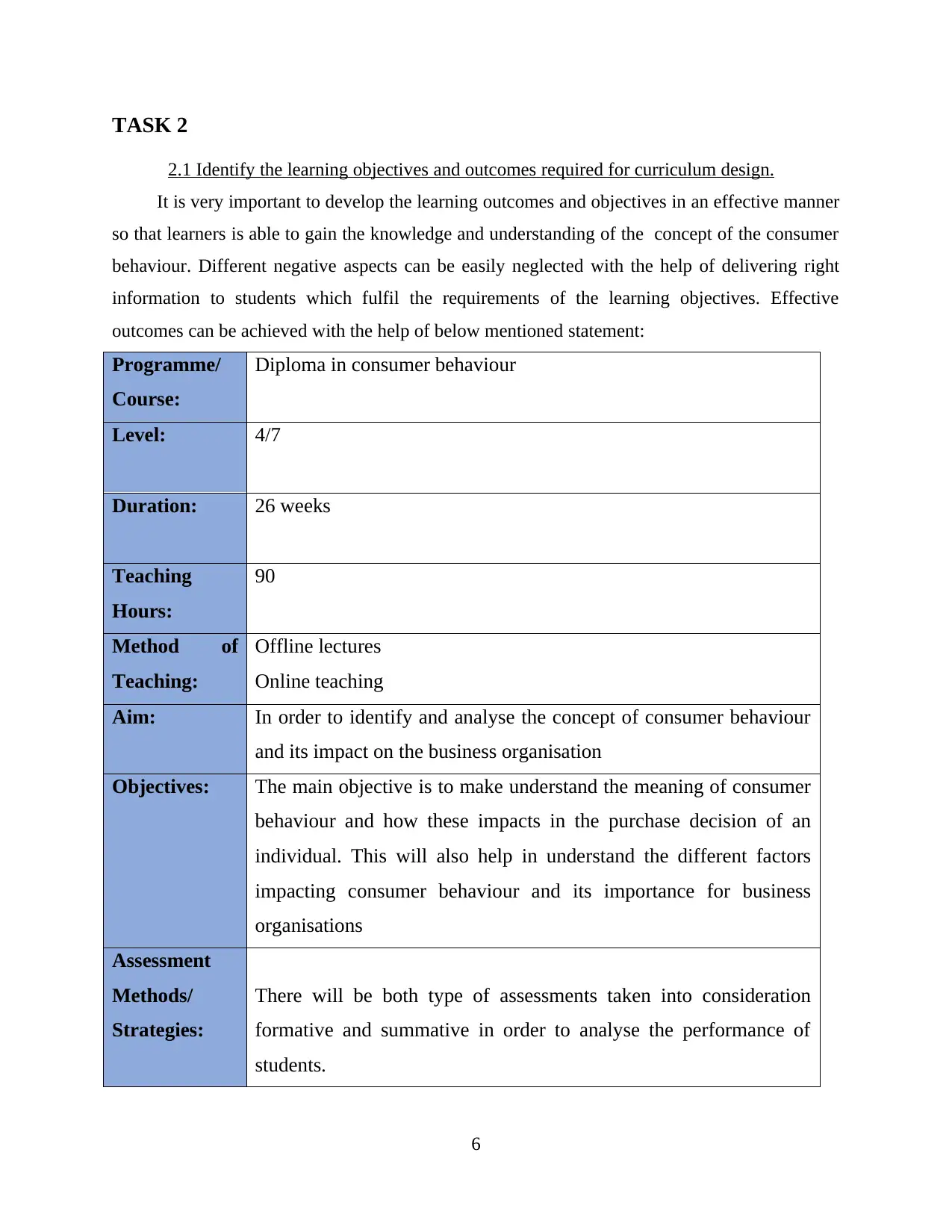
TASK 2
2.1 Identify the learning objectives and outcomes required for curriculum design.
It is very important to develop the learning outcomes and objectives in an effective manner
so that learners is able to gain the knowledge and understanding of the concept of the consumer
behaviour. Different negative aspects can be easily neglected with the help of delivering right
information to students which fulfil the requirements of the learning objectives. Effective
outcomes can be achieved with the help of below mentioned statement:
Programme/
Course:
Diploma in consumer behaviour
Level: 4/7
Duration: 26 weeks
Teaching
Hours:
90
Method of
Teaching:
Offline lectures
Online teaching
Aim: In order to identify and analyse the concept of consumer behaviour
and its impact on the business organisation
Objectives: The main objective is to make understand the meaning of consumer
behaviour and how these impacts in the purchase decision of an
individual. This will also help in understand the different factors
impacting consumer behaviour and its importance for business
organisations
Assessment
Methods/
Strategies:
There will be both type of assessments taken into consideration
formative and summative in order to analyse the performance of
students.
6
2.1 Identify the learning objectives and outcomes required for curriculum design.
It is very important to develop the learning outcomes and objectives in an effective manner
so that learners is able to gain the knowledge and understanding of the concept of the consumer
behaviour. Different negative aspects can be easily neglected with the help of delivering right
information to students which fulfil the requirements of the learning objectives. Effective
outcomes can be achieved with the help of below mentioned statement:
Programme/
Course:
Diploma in consumer behaviour
Level: 4/7
Duration: 26 weeks
Teaching
Hours:
90
Method of
Teaching:
Offline lectures
Online teaching
Aim: In order to identify and analyse the concept of consumer behaviour
and its impact on the business organisation
Objectives: The main objective is to make understand the meaning of consumer
behaviour and how these impacts in the purchase decision of an
individual. This will also help in understand the different factors
impacting consumer behaviour and its importance for business
organisations
Assessment
Methods/
Strategies:
There will be both type of assessments taken into consideration
formative and summative in order to analyse the performance of
students.
6
⊘ This is a preview!⊘
Do you want full access?
Subscribe today to unlock all pages.

Trusted by 1+ million students worldwide
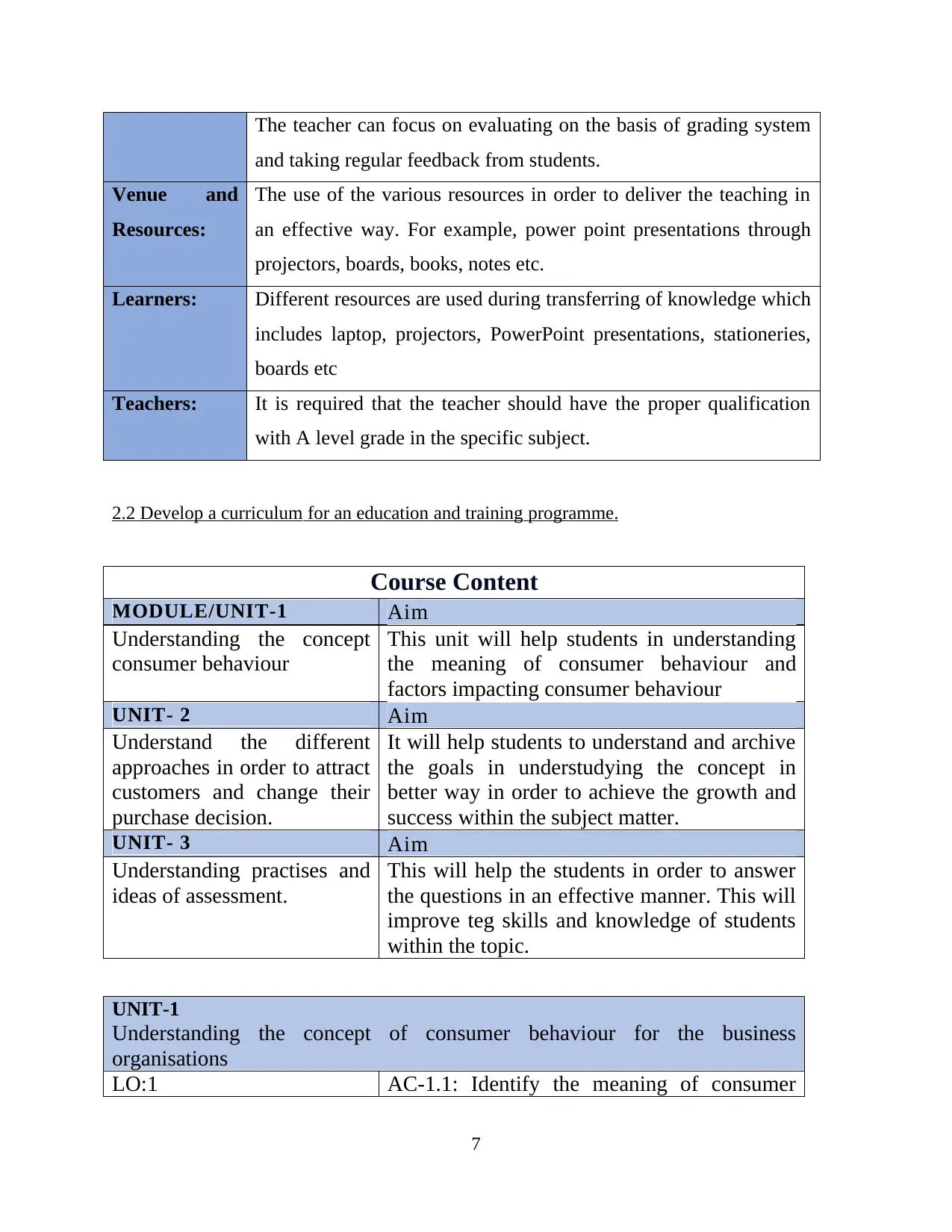
The teacher can focus on evaluating on the basis of grading system
and taking regular feedback from students.
Venue and
Resources:
The use of the various resources in order to deliver the teaching in
an effective way. For example, power point presentations through
projectors, boards, books, notes etc.
Learners: Different resources are used during transferring of knowledge which
includes laptop, projectors, PowerPoint presentations, stationeries,
boards etc
Teachers: It is required that the teacher should have the proper qualification
with A level grade in the specific subject.
2.2 Develop a curriculum for an education and training programme.
Course Content
MODULE/UNIT-1 Aim
Understanding the concept
consumer behaviour
This unit will help students in understanding
the meaning of consumer behaviour and
factors impacting consumer behaviour
UNIT- 2 Aim
Understand the different
approaches in order to attract
customers and change their
purchase decision.
It will help students to understand and archive
the goals in understudying the concept in
better way in order to achieve the growth and
success within the subject matter.
UNIT- 3 Aim
Understanding practises and
ideas of assessment.
This will help the students in order to answer
the questions in an effective manner. This will
improve teg skills and knowledge of students
within the topic.
UNIT-1
Understanding the concept of consumer behaviour for the business
organisations
LO:1 AC-1.1: Identify the meaning of consumer
7
and taking regular feedback from students.
Venue and
Resources:
The use of the various resources in order to deliver the teaching in
an effective way. For example, power point presentations through
projectors, boards, books, notes etc.
Learners: Different resources are used during transferring of knowledge which
includes laptop, projectors, PowerPoint presentations, stationeries,
boards etc
Teachers: It is required that the teacher should have the proper qualification
with A level grade in the specific subject.
2.2 Develop a curriculum for an education and training programme.
Course Content
MODULE/UNIT-1 Aim
Understanding the concept
consumer behaviour
This unit will help students in understanding
the meaning of consumer behaviour and
factors impacting consumer behaviour
UNIT- 2 Aim
Understand the different
approaches in order to attract
customers and change their
purchase decision.
It will help students to understand and archive
the goals in understudying the concept in
better way in order to achieve the growth and
success within the subject matter.
UNIT- 3 Aim
Understanding practises and
ideas of assessment.
This will help the students in order to answer
the questions in an effective manner. This will
improve teg skills and knowledge of students
within the topic.
UNIT-1
Understanding the concept of consumer behaviour for the business
organisations
LO:1 AC-1.1: Identify the meaning of consumer
7
Paraphrase This Document
Need a fresh take? Get an instant paraphrase of this document with our AI Paraphraser
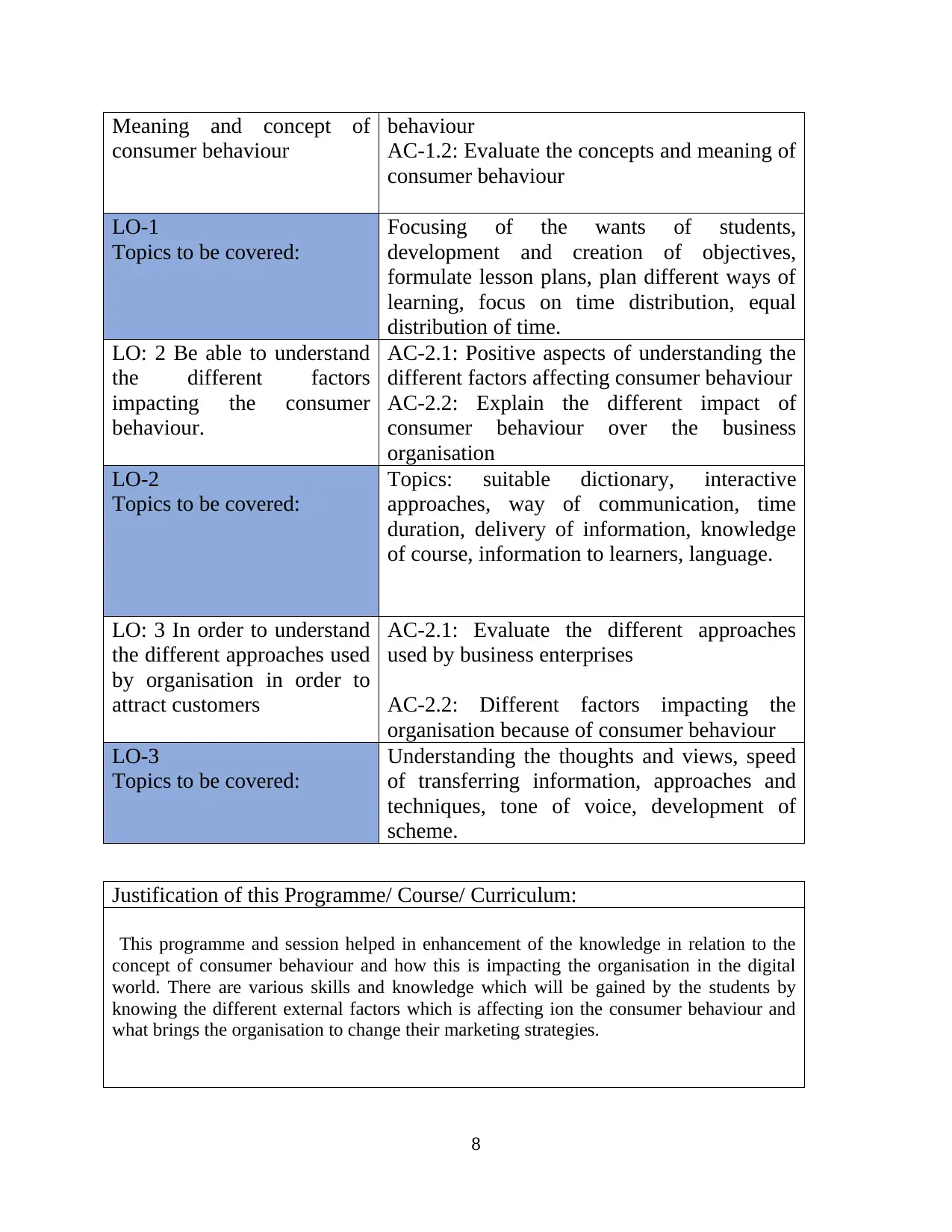
Meaning and concept of
consumer behaviour
behaviour
AC-1.2: Evaluate the concepts and meaning of
consumer behaviour
LO-1
Topics to be covered:
Focusing of the wants of students,
development and creation of objectives,
formulate lesson plans, plan different ways of
learning, focus on time distribution, equal
distribution of time.
LO: 2 Be able to understand
the different factors
impacting the consumer
behaviour.
AC-2.1: Positive aspects of understanding the
different factors affecting consumer behaviour
AC-2.2: Explain the different impact of
consumer behaviour over the business
organisation
LO-2
Topics to be covered:
Topics: suitable dictionary, interactive
approaches, way of communication, time
duration, delivery of information, knowledge
of course, information to learners, language.
LO: 3 In order to understand
the different approaches used
by organisation in order to
attract customers
AC-2.1: Evaluate the different approaches
used by business enterprises
AC-2.2: Different factors impacting the
organisation because of consumer behaviour
LO-3
Topics to be covered:
Understanding the thoughts and views, speed
of transferring information, approaches and
techniques, tone of voice, development of
scheme.
Justification of this Programme/ Course/ Curriculum:
This programme and session helped in enhancement of the knowledge in relation to the
concept of consumer behaviour and how this is impacting the organisation in the digital
world. There are various skills and knowledge which will be gained by the students by
knowing the different external factors which is affecting ion the consumer behaviour and
what brings the organisation to change their marketing strategies.
8
consumer behaviour
behaviour
AC-1.2: Evaluate the concepts and meaning of
consumer behaviour
LO-1
Topics to be covered:
Focusing of the wants of students,
development and creation of objectives,
formulate lesson plans, plan different ways of
learning, focus on time distribution, equal
distribution of time.
LO: 2 Be able to understand
the different factors
impacting the consumer
behaviour.
AC-2.1: Positive aspects of understanding the
different factors affecting consumer behaviour
AC-2.2: Explain the different impact of
consumer behaviour over the business
organisation
LO-2
Topics to be covered:
Topics: suitable dictionary, interactive
approaches, way of communication, time
duration, delivery of information, knowledge
of course, information to learners, language.
LO: 3 In order to understand
the different approaches used
by organisation in order to
attract customers
AC-2.1: Evaluate the different approaches
used by business enterprises
AC-2.2: Different factors impacting the
organisation because of consumer behaviour
LO-3
Topics to be covered:
Understanding the thoughts and views, speed
of transferring information, approaches and
techniques, tone of voice, development of
scheme.
Justification of this Programme/ Course/ Curriculum:
This programme and session helped in enhancement of the knowledge in relation to the
concept of consumer behaviour and how this is impacting the organisation in the digital
world. There are various skills and knowledge which will be gained by the students by
knowing the different external factors which is affecting ion the consumer behaviour and
what brings the organisation to change their marketing strategies.
8
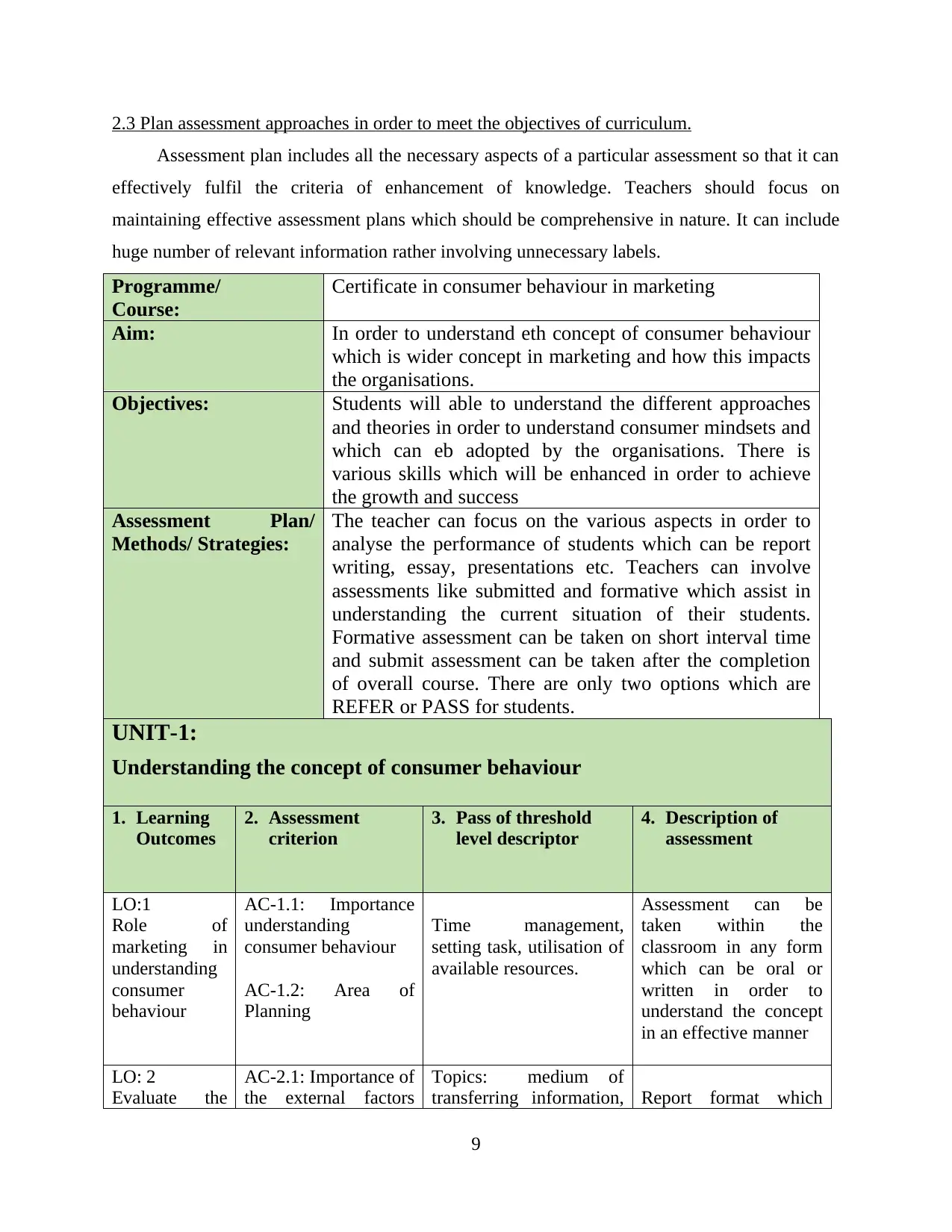
2.3 Plan assessment approaches in order to meet the objectives of curriculum.
Assessment plan includes all the necessary aspects of a particular assessment so that it can
effectively fulfil the criteria of enhancement of knowledge. Teachers should focus on
maintaining effective assessment plans which should be comprehensive in nature. It can include
huge number of relevant information rather involving unnecessary labels.
Programme/
Course:
Certificate in consumer behaviour in marketing
Aim: In order to understand eth concept of consumer behaviour
which is wider concept in marketing and how this impacts
the organisations.
Objectives: Students will able to understand the different approaches
and theories in order to understand consumer mindsets and
which can eb adopted by the organisations. There is
various skills which will be enhanced in order to achieve
the growth and success
Assessment Plan/
Methods/ Strategies:
The teacher can focus on the various aspects in order to
analyse the performance of students which can be report
writing, essay, presentations etc. Teachers can involve
assessments like submitted and formative which assist in
understanding the current situation of their students.
Formative assessment can be taken on short interval time
and submit assessment can be taken after the completion
of overall course. There are only two options which are
REFER or PASS for students.
UNIT-1:
Understanding the concept of consumer behaviour
1. Learning
Outcomes
2. Assessment
criterion
3. Pass of threshold
level descriptor
4. Description of
assessment
LO:1
Role of
marketing in
understanding
consumer
behaviour
AC-1.1: Importance
understanding
consumer behaviour
AC-1.2: Area of
Planning
Time management,
setting task, utilisation of
available resources.
Assessment can be
taken within the
classroom in any form
which can be oral or
written in order to
understand the concept
in an effective manner
LO: 2
Evaluate the
AC-2.1: Importance of
the external factors
Topics: medium of
transferring information, Report format which
9
Assessment plan includes all the necessary aspects of a particular assessment so that it can
effectively fulfil the criteria of enhancement of knowledge. Teachers should focus on
maintaining effective assessment plans which should be comprehensive in nature. It can include
huge number of relevant information rather involving unnecessary labels.
Programme/
Course:
Certificate in consumer behaviour in marketing
Aim: In order to understand eth concept of consumer behaviour
which is wider concept in marketing and how this impacts
the organisations.
Objectives: Students will able to understand the different approaches
and theories in order to understand consumer mindsets and
which can eb adopted by the organisations. There is
various skills which will be enhanced in order to achieve
the growth and success
Assessment Plan/
Methods/ Strategies:
The teacher can focus on the various aspects in order to
analyse the performance of students which can be report
writing, essay, presentations etc. Teachers can involve
assessments like submitted and formative which assist in
understanding the current situation of their students.
Formative assessment can be taken on short interval time
and submit assessment can be taken after the completion
of overall course. There are only two options which are
REFER or PASS for students.
UNIT-1:
Understanding the concept of consumer behaviour
1. Learning
Outcomes
2. Assessment
criterion
3. Pass of threshold
level descriptor
4. Description of
assessment
LO:1
Role of
marketing in
understanding
consumer
behaviour
AC-1.1: Importance
understanding
consumer behaviour
AC-1.2: Area of
Planning
Time management,
setting task, utilisation of
available resources.
Assessment can be
taken within the
classroom in any form
which can be oral or
written in order to
understand the concept
in an effective manner
LO: 2
Evaluate the
AC-2.1: Importance of
the external factors
Topics: medium of
transferring information, Report format which
9
⊘ This is a preview!⊘
Do you want full access?
Subscribe today to unlock all pages.

Trusted by 1+ million students worldwide
1 out of 21
Related Documents
Your All-in-One AI-Powered Toolkit for Academic Success.
+13062052269
info@desklib.com
Available 24*7 on WhatsApp / Email
![[object Object]](/_next/static/media/star-bottom.7253800d.svg)
Unlock your academic potential
Copyright © 2020–2025 A2Z Services. All Rights Reserved. Developed and managed by ZUCOL.


